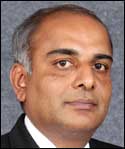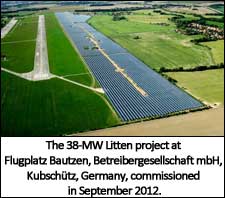 K.M. Santosh,
K.M. Santosh,
Managing Director,
Enerparc Energy Pvt. Ltd
Enerparc Energy Pvt. Ltd of Bengaluru specialises in EPC work for solar photovoltaic projects, both large-scale free field and rooftop mounted. K.M. Santosh, who leads Enerparc’s Indian business, has rich experience in solar energy in Indian and international markets. In an email interaction with Lalitha Rao, he outlines the company’s plans for providing EPC services to project developers in the Indian solar market.
Solar energy is a relatively new industry in India. Given this, what challenges do you typically face? In particular, do you encounter manpower-related difficulties?
Acquiring and retaining experienced professionals in solar industry were clearly a big problem a couple of years ago when solar started in India. Now is a good pool of professionals with experience in solar energy in India. However in certain areas like design and installation there is still a dearth of experienced talent pool.
Owing to very aggressive tariffs that project developers offered in last few years the pressure on cutting costs in construction is high. In many cases this leads to compromises in long term project life. Thankfully, in recent past there are more realistic tariffs that are being offered so market has matured to an extent.
Lead time of construction is still an issue in India. Typically, a solar project takes anywhere between 12 weeks to 18 weeks to build. This is owing to lead times from certain component manufacturers.
Financing solar projects remains one of the key challenges in India. A predominantly recourse debt funding route that exists now should shift to non recourse one where project risks and returns mainly drive debt funding.
Lastly, land acquisition is always a challenge. Solar parks that are created in some parts of India are a wonderful way to mitigate this problem.
The tariffs offered by potential developers are becoming competitive and developers would be working within tight capital costs. Assuming that capital costs of solar equipment have come down, do you feel that this tariff competition is exerting pressure on EPC contractors?
No doubt, solar equipment costs have been driven down to some extent by competitive tariff bidding by developers. Also, in 2011 and early 2012, owing to an oversupply in global solar modules, prices in Indian market fell drastically. This has got corrected already. In the last two quarters solar module prices have stabilised and to an extent hardened. A large domestic project development portfolio within China and an attractive priced Japanese market has partly resulted in this price hardening. As far as balance of system costs are concerned, competitive bidding has resulted in these costs getting optimised in India.
The margin in EPC business is small. As equipment costs gets hardened the EPC price also stabilises. Price reduction should not compromise asset quality as long-term performance of the asset is important for developers to realise returns. So, one should not just look at initial investments but on life time costs for the solar project to operate to its full capacity. This awareness has certainly come as can see a maturity in prices being offered by developers for recent solar bids
Solar power, at least today, is dependent on government support. What is your view? Do you think that technology can bring about further reduction in capital costs and the much talked about parity with conventional (coal-fired) power?
Parity with conventional mainstream power is already achieved in certain states in India for certain electricity tariff levels. Commercial electricity tariff in some states are higher than solar levelised tariff (which is close to Rs. 7.2 to 7.5/kwh). In one of the recent project we commissioned in New Delhi, the solar energy costs are close to Rs. 1.5/kwh lower than what the customer is currently paying for grid electricity.
While for commercial segments parity is achieved in some states, for industrial customers it would take a couple of years. A combination of increasing grid electricity prices and marginally reducing solar capital costs will drive parity. New technologies like CIGS which are in initial deployment phase promise to drive costs down too. The residential sector parity will take a longer time as the grid electricity rates are lower for this segment than Industrial and commercial.
 Tell us about Enerpac’s international business with respect to EPC contracting for solar power plants. Which countries or regions today hold high potential?
Tell us about Enerpac’s international business with respect to EPC contracting for solar power plants. Which countries or regions today hold high potential?
Enerparc has executed more than 1,000 MW of solar EPC projects globally. In addition, we also have our Independent Power Producer asset base in solar energy of 650 MW. We also have a 600 MW portfolio of solar projects under long term O&M contracts.
Global solar market is in transition. Europe led by Germany was till last year one of the largest global markets. Now China, Japan, USA and India are emerging as dominant markets for solar energy installations. Enerparc have presence in USA and in India to be part of these growing markets apart from our traditional strong presence in Europe.
What is Enerparc’s India operation? How do you see the scope for solar power projects in India given the impetus provided by the National Solar Mission?
Enerparc is focused on developing solar projects and not into manufacturing solar equipment. We strongly believe that Indian solar market has immense potential for solar energy and will continue to grow over many years. We have a long term interest in this market.
There are two different markets in India. The larger market that has resulted in an installed capacity of more than 2 GW is the government policy driven market. There is also a small but emerging retail energy market where solar energy can be used by end users to replace part of electricity drawn from grid and for certain states and customer segments like commercial establishments solar energy costs can be cheaper than grid electricity tariffs. The government policy driven market has provided the big push to develop solar in India and going forward the retail energy market has potential to grow bigger.
Enerparc is focusing on providing EPC services to project developers in Indian solar market; both for Government policy enabled projects as well as retail energy segment.
Tell us about some major projects (contracts) completed or under execution by Enerparc and discuss in general your future plans for Enerpac’s solar business, given India’s huge solar potential.
Enerparc has completed a first-of-its-kind project in New Delhi International Airport where we have installed a solar project in vacant land adjacent to the runway of the airport. This is the largest project inside an active airport and adjacent to runway in India. The airport, as I stated earlier, benefits from reduced cost of electricity owing to solar project and can also get carbon ratings and green ratings. We are also in the process of looking at similar projects for commercial establishments in South India.
Enerparc will continue to focus on EPC services, trade services as well as in near future development/investing activities both in primary and secondary market in India. We believe that India has an immense potential and we will be part of the Indian solar growth story











